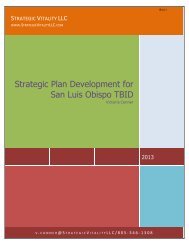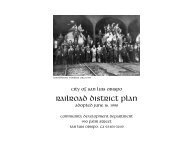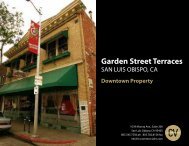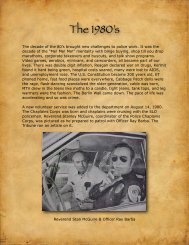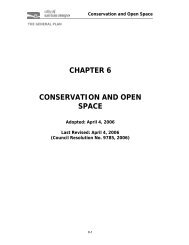The 1990's - the City of San Luis Obispo
The 1990's - the City of San Luis Obispo
The 1990's - the City of San Luis Obispo
You also want an ePaper? Increase the reach of your titles
YUMPU automatically turns print PDFs into web optimized ePapers that Google loves.
<strong>The</strong> 1990’s<br />
<strong>The</strong> 1990’s broke through as <strong>the</strong> age <strong>of</strong> electronics. Many changes took place<br />
that affect today’s world.<br />
• <strong>The</strong> World Wide Web was born in 1992 and by 1998 <strong>the</strong>re were over<br />
100 million people surfing it.<br />
• Cyber crime was born and <strong>the</strong> good, <strong>the</strong> bad, and <strong>the</strong> ugly got to surf<br />
along with <strong>the</strong> rest <strong>of</strong> us.<br />
• In 1992 <strong>the</strong> riots erupted in LA over <strong>the</strong> Rodney King video tape<br />
• <strong>The</strong> World Trade Center was bombed in 1993<br />
• <strong>The</strong> tragedy in Waco, Texas took place in 1993<br />
• <strong>The</strong> O.J. Simpson trial ended in 1995 with a verdict that is still debated<br />
today<br />
• <strong>The</strong> Federal Building was bombed in Oklahoma in 1995 by one <strong>of</strong> our<br />
own<br />
• In 1999 <strong>the</strong> Columbine High School tragedy shocked <strong>the</strong> nation.<br />
• “Grunge versus Preppy” fought for <strong>the</strong> young ones<br />
• Hip hop styles with big pants for <strong>the</strong> boys and hip hugger pants for <strong>the</strong><br />
girls came into vogue.<br />
• In-line skates wowed <strong>the</strong> younger crowd as well as Beanie Babies,<br />
Furby, Tickle Me Elmo, and yo yos.<br />
• <strong>The</strong> greatest rage with old and young alike was <strong>the</strong> personal computer.<br />
Also video games in <strong>the</strong> forms <strong>of</strong> X box, Nintendo, and Playstation<br />
riveted young and old to <strong>the</strong>ir chairs.<br />
This new world brought many new challenges to law enforcement. Every<br />
arrest was scrutinized in regard to civil rights, which made it necessary for<br />
police units to have video surveillance <strong>of</strong> stops and arrests for everyone’s<br />
protection. Officers were expected to keep up with <strong>the</strong> technology <strong>of</strong> <strong>the</strong> day<br />
so <strong>the</strong>y could assist with investigations into identity <strong>the</strong>ft, bogus money,<br />
predators preying on children via <strong>the</strong> web, and terrorism.
Sergeant Jerry Lenthall & Officer Al Webster<br />
<strong>The</strong> decade started out with a bang in 1990. In April <strong>of</strong> 1990 <strong>the</strong> Poly Royal<br />
celebration spun out <strong>of</strong> control and became a riot that lasted for three days. <strong>The</strong><br />
Poly Royal Open House weekend tradition started back in 1938 as an open<br />
house for students and parents to come and see what was happening here. It<br />
evolved over <strong>the</strong> years to include a rodeo, tractor pull, parade, and many o<strong>the</strong>r<br />
events.<br />
Sergeant Pete Hubbard & Chief Jim Gardiner<br />
However, something went terribly wrong in 1990 and <strong>the</strong> students and police<br />
clashed in a way that still resounds today. Over 120 people were arrested after<br />
three days <strong>of</strong> rioting. Any object within reach was hurled at police <strong>of</strong>ficers,<br />
including small explosives (cheery bombs and at least two Molotov cocktails).<br />
Bottles flew through <strong>the</strong> air and noisy revelers bashed store front windows.<br />
Much <strong>of</strong> <strong>the</strong> rioting took place at <strong>the</strong> Foothill-California intersection. When all<br />
was said and done, <strong>the</strong>re was plenty <strong>of</strong> property damage and certainly damaged<br />
nerves. More than 100 people were injured, including 15 police <strong>of</strong>ficers. As a
esult, Poly Royal was cancelled, though in recent years <strong>the</strong> school has brought<br />
back some <strong>of</strong> <strong>the</strong> low key events under <strong>the</strong> name “Cal Open House.”<br />
Understandably, <strong>the</strong> department is uneasy each spring when <strong>the</strong> Cal Poly Open<br />
House arrives with <strong>the</strong> more subdued program.<br />
In 1993 <strong>the</strong> department brought a new program to <strong>the</strong> table. This was a<br />
system <strong>of</strong> Peer Party Police. On February 17, 1993, <strong>the</strong> Tribune ran an article<br />
entitled “SLO Council OK’s Peer Party Police.”<br />
“Students will be <strong>the</strong> first to respond to loud party complaints<br />
under a peer policing program approved by <strong>the</strong> <strong>San</strong> <strong>Luis</strong> <strong>Obispo</strong><br />
<strong>City</strong> Council. <strong>The</strong> Student Neighborhood Assistance Program<br />
(SNAP), a cooperative effort between <strong>the</strong> Police Department and<br />
Cal Poly, is set to begin next September. Trained students would<br />
assist police by responding to unruly parties first. Such calls, a<br />
staff report says, numbered 2,400 in 1991 and took up 900<br />
hours <strong>of</strong> police time.<br />
“‘SNAP presents a unique opportunity to develop a collaborative<br />
approach to deal with <strong>the</strong> issue <strong>of</strong> noise in <strong>the</strong> community.’ said<br />
Chief Jim Gardiner. ‘<strong>The</strong> intent <strong>of</strong> <strong>the</strong> program is for <strong>the</strong> student<br />
patrol to get partygoers to quiet down and avoid police calls. By<br />
doing so,’ Gardiner said, ‘SNAP could free police to deal with<br />
more serious crime.’<br />
“‘<strong>The</strong> Council’s approval concluded years <strong>of</strong> research on SNAP,’<br />
said police Captain Bart Topham. <strong>The</strong> program was approved by<br />
Cal Poly’s Associated Students, Inc. in October 1992. ‘We’re<br />
very pleased,’ Topham said. ‘<strong>The</strong> <strong>City</strong> Council has been very<br />
supportive <strong>of</strong> <strong>the</strong> concept from <strong>the</strong> beginning.’<br />
“’Last night’s action by <strong>the</strong> Council earmarked over $15,000 to<br />
be spent from <strong>the</strong> police budget to get <strong>the</strong> program running,’<br />
Topham said. ‘That money will be spent on student patrollers,<br />
equipment, and training. Details about continued financing <strong>of</strong><br />
<strong>the</strong> program still have to be worked out,’ Gardiner said.<br />
“Topham said that between now and September, <strong>the</strong> SNAP<br />
program needs to be brought to <strong>the</strong> public’s attention. During<br />
that time employees will be selected and trained by completing<br />
ride-alongs with police <strong>of</strong>ficers. Topham said <strong>the</strong> program would<br />
likely start with one or two teams <strong>of</strong> two people. <strong>The</strong> program<br />
will <strong>the</strong>n be analyzed as to how it’s working and how it can be<br />
expanded.
“Topham said he doesn’t see any problems in sending students<br />
to break up student parties. ‘It’s a heck <strong>of</strong> a lot better than<br />
having a cop show up with a ticket,’ Topham said.”<br />
Rick Crocker, DARE Officer 1992<br />
Ano<strong>the</strong>r innovation in <strong>the</strong> department was <strong>the</strong> Bicycle Unit. In October 1996<br />
an article appeared,“SLO Bike Patrol Put On Fast Track.” Pictured in this<br />
article is Officer Tim Hedges patrolling Pismo Street on his bike that was<br />
made possible through a $500 donation from <strong>the</strong> SLO Bike Club.<br />
“Police presence downtown will increase thanks to a collaborative effort<br />
that is providing <strong>of</strong>fice space and a bicycle for pedal pushing patrols.
“Tim Hedges, downtown <strong>of</strong>ficer for <strong>San</strong> <strong>Luis</strong> <strong>Obispo</strong> Police Department,<br />
will conduct police business from <strong>the</strong> downtown <strong>of</strong>fice, which will be<br />
linked via computer to <strong>the</strong> main police headquarters on Walnut Street.<br />
Copeland’s Sports donated space for <strong>the</strong> <strong>of</strong>fice at 840 Marsh Street and<br />
<strong>the</strong> Business Improvement Association contributed money.<br />
“‘I really want to emphasize <strong>the</strong> partnership that allowed this thing to<br />
happen,’ said Police Chief Jim Gardiner during a kick-<strong>of</strong>f presentation<br />
Thursday morning. ‘We needed space and <strong>the</strong> Copeland family stepped<br />
forward.’ In <strong>the</strong> future, <strong>the</strong> <strong>of</strong>fice may become open to <strong>the</strong> general public,<br />
according to a police department release.<br />
“A specially equipped bicycle, which Hedges will use to supplement his<br />
regular foot patrols, will allow him to patrol <strong>the</strong> downtown with greater<br />
frequency. While police <strong>of</strong>ficers have patrolled on bicycles previously,<br />
Hedges will be <strong>the</strong> first <strong>of</strong>ficial bike <strong>of</strong>ficer, Gardiner said. Hedges said <strong>the</strong><br />
bicycle will afford him more visibility downtown. ‘People will see me more<br />
<strong>of</strong>ten.’ he said.<br />
“Deborah Holley, administrator for <strong>the</strong> Business Improvement<br />
Association, said Hedges has provided a great service to <strong>the</strong> downtown<br />
since <strong>the</strong> city began <strong>the</strong> Downtown Officer Program about a year ago. ‘He<br />
has been very helpful in addressing complaints that people have. He is<br />
very accessible and very quick to respond,’ she said. <strong>The</strong> BIA donated<br />
$1000 to assist <strong>the</strong> expansion <strong>of</strong> <strong>the</strong> program.”<br />
Rachel Newhouse<br />
On November 13 , 1998, <strong>the</strong> police received a report <strong>of</strong> a missing person. It<br />
was reported that a 20-year old Cal Poly student named Rachel Newhouse<br />
had not been seen since she left her friends after socializing at Tortilla Flats<br />
Restaurant downtown. She left on her own, walking toward home around
midnight. Her roommate became concerned when she did not return and<br />
called police <strong>the</strong> following day.<br />
A massive search was launched to find her. Police called on her family,<br />
friends, and acquaintances. Flyers were posted all over town and <strong>the</strong> media<br />
got <strong>the</strong> word out to assist in <strong>the</strong> search. Her picture was everywhere and<br />
police, <strong>the</strong> FBI, and Sheriffs deputies contacted anyone connected in any<br />
way with <strong>the</strong> student. Rewards were <strong>of</strong>fered for information as to her<br />
whereabouts. Some blood was reported on <strong>the</strong> Jennifer Street Bridge near<br />
<strong>the</strong> Amtrak station. This was analyzed with <strong>the</strong> result <strong>of</strong> a DNA match--<strong>the</strong><br />
blood was an 8 million to one chance <strong>of</strong> most likely belonging to Rachel<br />
Newhouse. It appeared that she had been <strong>the</strong>re, she had been hurt, and<br />
likely taken somewhere else by vehicle. In spite <strong>of</strong> extensive efforts by all<br />
<strong>the</strong> local authorities <strong>the</strong>re was no trace <strong>of</strong> Rachel.<br />
Aundria Crawford<br />
On March 12, 1999, a frantic mo<strong>the</strong>r called <strong>the</strong> authorities to say she was<br />
concerned because she wasn’t able to contact her daughter who lived in <strong>San</strong><br />
<strong>Luis</strong> <strong>Obispo</strong>. She had been trying to get in touch with her both by phone and<br />
pager and <strong>the</strong>re was no response. Her daughter was Aundria Crawford, a 20-<br />
year old Cuesta student. Aundria and her mo<strong>the</strong>r were very close and spoke<br />
to each o<strong>the</strong>r frequently. For her to be out <strong>of</strong> contact was very unusual. <strong>The</strong><br />
police sent a unit to her home and found signs <strong>of</strong> a break-in and a struggle.<br />
It appeared she had been unloading her groceries from her car and someone<br />
was in <strong>the</strong> house when she entered. He had come in through <strong>the</strong> bathroom<br />
window and had been waiting for her return. Aundria, too, became <strong>the</strong><br />
subject <strong>of</strong> a massive manhunt by all <strong>the</strong> law enforcement agencies in <strong>the</strong><br />
area.
On March 20, 1999, parole <strong>of</strong>ficer David Zaragoza paid a call on a parolee,<br />
Rex Allen Krebs, in his home in Avila Valley. Mr. Krebs was a known sex<br />
<strong>of</strong>fender and was checked on periodically by Officer Zaragoza. Rex Allen<br />
Krebs was a 33-year old, originally from Idaho, who had been convicted in<br />
California in 1987 on charges <strong>of</strong> rape, sodomy, assault with intent to commit<br />
rape, and three burglaries. <strong>The</strong> crimes involved a rape in Oceano and a rape<br />
attempt in Arroyo Grande. He was sentenced to 20 years in prison but he<br />
was paroled in 10 years. He had been living for <strong>the</strong> past eight months in<br />
Davis Canyon and worked at a local lumber store in <strong>San</strong> <strong>Luis</strong> <strong>Obispo</strong>. On this<br />
particular visit Officer Zaragoza took Krebs into custody for parole violations<br />
that included having a simulated firearm and alcoholic beverages in his<br />
home. What was later discovered, as <strong>the</strong> details <strong>of</strong> <strong>the</strong> two missing girls was<br />
shared among law enforcement personnel, was that property that matched a<br />
description <strong>of</strong> something belonging to Aundria Crawford was seen by<br />
Zaragoza in Kreb’s home.<br />
Krebs was taken into custody and questioned by police and DA Investigator<br />
Larry Hobson. He confessed his involvement in <strong>the</strong> girls’ kidnappings and<br />
subsequent murders to Hobson. As a result <strong>of</strong> <strong>the</strong>se confessions <strong>the</strong> police<br />
were able to get a warrant to search his home and surrounding land. <strong>The</strong><br />
bodies <strong>of</strong> both women were recovered. It was discovered that <strong>the</strong>y had been<br />
brutally raped, tortured, and murdered. <strong>The</strong> trial took place in Monterey, as<br />
a change <strong>of</strong> venue was awarded <strong>the</strong> defense. It was completed on July 21,<br />
2001, and Krebs was sentenced to <strong>the</strong> death penalty.<br />
So ended a very sad and very difficult case. Rachel and Aundria are still<br />
commemorated each year by o<strong>the</strong>r young women who mourn <strong>the</strong>ir loss to<br />
violence. <strong>The</strong> hard work <strong>of</strong> everyone involved speaks to <strong>the</strong> commitment and<br />
untiring efforts <strong>of</strong> countless <strong>of</strong>ficers in law enforcement who gave hundreds<br />
<strong>of</strong> hours <strong>of</strong> time and dedication to solving <strong>the</strong>se terrible crimes.
Downtown Bike Officers Eric Lincoln & Cindy Dunn<br />
On September 3, 1999, an article appeared in <strong>the</strong> Tribune titled “Thin Blue<br />
Line Getting a bit Thicker in SLO.” It reads as follows.<br />
“A steady rise in bad behavior downtown has spurred <strong>the</strong> Police<br />
Department to hire two new <strong>of</strong>ficers. <strong>The</strong> new cops, whose<br />
presence will allow for <strong>the</strong> Downtown Unit’s current force to<br />
increase from one <strong>of</strong>ficer to three, should be on <strong>the</strong> streets by<br />
mid-September. <strong>The</strong> Police Department has timed <strong>the</strong> staff<br />
additions to coincide with <strong>the</strong> influx <strong>of</strong> college students at <strong>the</strong><br />
onset <strong>of</strong> <strong>the</strong> new school year.<br />
“‘Downtown calls account for about 20% <strong>of</strong> <strong>the</strong> department’s<br />
workload,’ said Bart Topham, a captain with <strong>the</strong> department.<br />
‘<strong>The</strong>re’s no question that assaultive behavior has been up in <strong>the</strong><br />
last couple <strong>of</strong> years. <strong>The</strong>re’s more drinking, more fighting, more<br />
traffic, more skateboarders, more everything you can imagine.’<br />
“<strong>The</strong> police proposed <strong>the</strong> additions last winter in a two-year<br />
budget that kicked in this July.”



